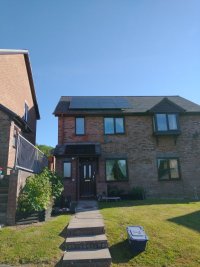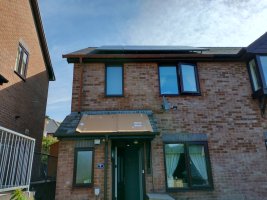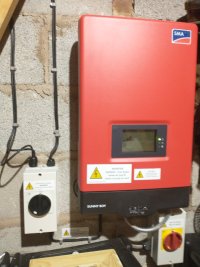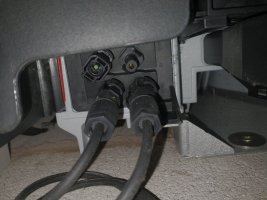I sincerely hope that those in the know-how would be able to assist me. On my semi-detached house we have an existing 2kW system (8 panels, 250w each), this was installed 9 years ago, with the inverter SMA Sunny Boy 2kw (SB 2000HF-30), and recently we added a 400w single panel over our porch just to add bit extra as we are planning to have a battery installed in the near future. It appeared that the inverter can/could accommodate a 2nd string.
During the installation the electrician attempted to connect the new panel into the 2nd string, however the inverter didn't like that at all and it wouldn't power up for some strange reason, then the installer connected it through the existing isolator box (so, two seperate feeds into it and then the single feed going out to the inverter) and still the inverter didnt like that either. Then he placed an optimiser onto the new panel and then it worked for some strange reason. He was really puzzled about all this especially why the inverter wasn't accepting this single panel, but it worked and we left it to that.
Achieved larger generation than usually we would at this time of year, but in the last couple of days with this sunny weather I noted that in the morning (8am) when was really bright outside (although sun is still to the side of the house and not fully shining onto the main 8 panels no shade on them in the morning whatsoever) the system was producing only 200w. I am monitoring this via Solo PV monitor. I thought that it should be definitely more than 200w given the brightness. I had a large piece of cardboard and covered the new singe panel over the porch just to see what would happen, and monitor indicated a drop down to 10w. This indicated that only new 400w panel was generating any electric at that time albeit being in the shade (as the sun hasn't come yet to that side of the house which is apx around 10.30am this time of the year (we are facing SW).
New panel remained covered with the cardboard and after about 5min main panels kicked in and monitor showed 800w generation from them. I uncovered the new panel and production increased by 60w to 860w and started to increase steadily as the sun was moving. As soon as the new panel came into the sun around 10:40 massive increase in production and most of the day we were generating 2kWph. Unfortunately, house roof goes in the shade around 5.30pm but we manage to clock 12.5kW that day. So the system works to its full potential/capacity when all the panels are in the sun, but something is preventing the main panels starting in the morning.
This is happening now constantly in the morning and even yesterday when we had that mini 1 day heatwave, I did this cardboard cover re-set of the one over the porch and then the main top 8 panels got awaken and started to produce 800w and increased as the sun was coming around.
In the late afternoon when the new panel goes first in the shade the generation accordingly drops and the main top panels carry on working fine until they go in the shade and start shutting down (no optimisers have been installed on them just one the new panel).
As it was really cloudy today the generation was only showing 200w, I covered the porch panel again to test it, and the generation dropped to 10w, and after 5min the top panels kicked in and showed around 300w while the one was still covered. Uncovered the porch one and production increased to 430w, remained like that for a bit and the cloud cover increased and production dropped down to 160w apx.
So I am really confused why the main panels would not start producing on a low lux levels while the 400w panel would be generating 200w while being in the shade and on a cloudy day without direct sunlight as well and with the installed optimiser. Like I said once the all of the panels are in the sun (well it appears that once the porch single panel comes in the direct light all system works fine as it should).
I have informed the installer/electrician of this and he is finding it really strange, but he hasn't had a chance to come around to have a look yet.
Any thoughts on this strange issue, could it be they way the new panel is connected through the existing isolator as that was the only option due to the inverter not accepting the 2nd separate string, but why the generation from a smaller separate 400w panel would record production by the inverter but no production from 8 (250w) panels? Something is preventing the main system kicking in when its clear that the smaller panel is trickling small amount of energy.
Sorry for such a long explanation just trying to give you a full picture of the issue.




During the installation the electrician attempted to connect the new panel into the 2nd string, however the inverter didn't like that at all and it wouldn't power up for some strange reason, then the installer connected it through the existing isolator box (so, two seperate feeds into it and then the single feed going out to the inverter) and still the inverter didnt like that either. Then he placed an optimiser onto the new panel and then it worked for some strange reason. He was really puzzled about all this especially why the inverter wasn't accepting this single panel, but it worked and we left it to that.
Achieved larger generation than usually we would at this time of year, but in the last couple of days with this sunny weather I noted that in the morning (8am) when was really bright outside (although sun is still to the side of the house and not fully shining onto the main 8 panels no shade on them in the morning whatsoever) the system was producing only 200w. I am monitoring this via Solo PV monitor. I thought that it should be definitely more than 200w given the brightness. I had a large piece of cardboard and covered the new singe panel over the porch just to see what would happen, and monitor indicated a drop down to 10w. This indicated that only new 400w panel was generating any electric at that time albeit being in the shade (as the sun hasn't come yet to that side of the house which is apx around 10.30am this time of the year (we are facing SW).
New panel remained covered with the cardboard and after about 5min main panels kicked in and monitor showed 800w generation from them. I uncovered the new panel and production increased by 60w to 860w and started to increase steadily as the sun was moving. As soon as the new panel came into the sun around 10:40 massive increase in production and most of the day we were generating 2kWph. Unfortunately, house roof goes in the shade around 5.30pm but we manage to clock 12.5kW that day. So the system works to its full potential/capacity when all the panels are in the sun, but something is preventing the main panels starting in the morning.
This is happening now constantly in the morning and even yesterday when we had that mini 1 day heatwave, I did this cardboard cover re-set of the one over the porch and then the main top 8 panels got awaken and started to produce 800w and increased as the sun was coming around.
In the late afternoon when the new panel goes first in the shade the generation accordingly drops and the main top panels carry on working fine until they go in the shade and start shutting down (no optimisers have been installed on them just one the new panel).
As it was really cloudy today the generation was only showing 200w, I covered the porch panel again to test it, and the generation dropped to 10w, and after 5min the top panels kicked in and showed around 300w while the one was still covered. Uncovered the porch one and production increased to 430w, remained like that for a bit and the cloud cover increased and production dropped down to 160w apx.
So I am really confused why the main panels would not start producing on a low lux levels while the 400w panel would be generating 200w while being in the shade and on a cloudy day without direct sunlight as well and with the installed optimiser. Like I said once the all of the panels are in the sun (well it appears that once the porch single panel comes in the direct light all system works fine as it should).
I have informed the installer/electrician of this and he is finding it really strange, but he hasn't had a chance to come around to have a look yet.
Any thoughts on this strange issue, could it be they way the new panel is connected through the existing isolator as that was the only option due to the inverter not accepting the 2nd separate string, but why the generation from a smaller separate 400w panel would record production by the inverter but no production from 8 (250w) panels? Something is preventing the main system kicking in when its clear that the smaller panel is trickling small amount of energy.
Sorry for such a long explanation just trying to give you a full picture of the issue.





